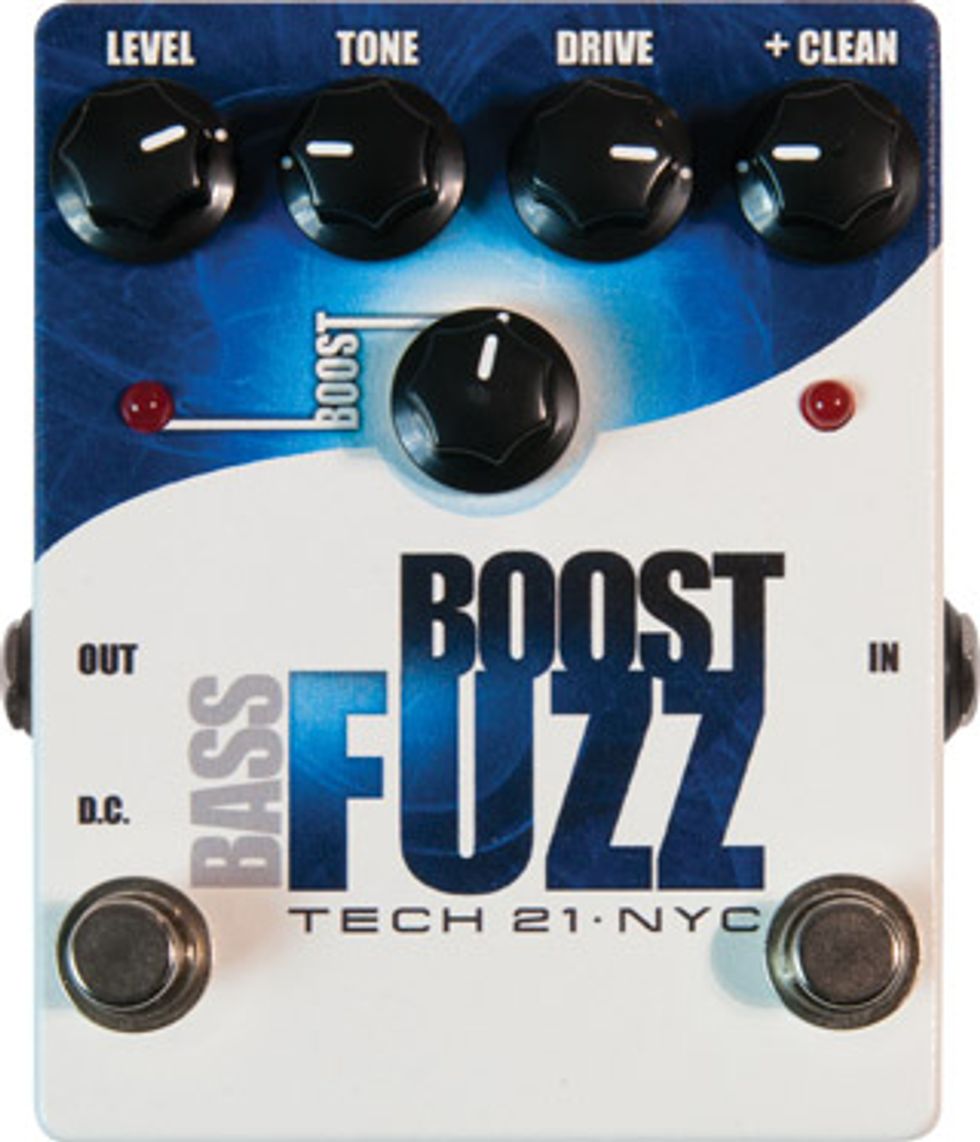
Used in studios and on stages around the world for over 20 years, Tech 21’s SansAmp devices have been praised for their tube-amp emulation. And with all-analog circuitry and a buffered bypass, Tech 21’s effects pedals also display the company’s “vintage-in-a-box” mentality. Having been applauded by bassists for their improvement to the “typical” chorus pedal with the Bass Boost Chorus, Tech 21 has recently introduced their take on classic fuzz for bassists, fittingly named the Bass Boost Fuzz.
Fuzz Tones for All
Tech 21 created the Bass Boost
Fuzz with inspiration from its
counterpart for guitarists, the
Boost Fuzz. Emulating the classic
sound of germanium transistors,
this pedal solves some of the
issues associated with the older
fuzz boxes. Tech 21 believes that
bassists were frustrated with
using earlier fuzz pedals, which
typically catered to guitar frequencies.
As a result, the bottom
end of their tone would disappear
because the effects were not
voiced for the bass.
The Bass Boost Fuzz offers five knobs for dialing in that perfect sound. Adjusting the level adds fuzz, while the clean knob blends in the instrument’s initial signal. The tone knob is described as a specialized low-pass filter that shifts the high cut from 10 kHz to 1 kHz. In other words, the pedal delivers a fuzz tone ranging from a warm, mellow buzz, to an edgy and biting grind. The amount of fuzz can then be tempered with the drive dial, which also responds to volume adjustments from the instrument in hand.
As its name implies, a bonus feature on the Bass Boost Fuzz is the boost function, and this fifth knob offers the player a massive 21 dB of clean boost. The boost works post-effect, so it increases the signal without adding more distortion. And because it’s operated by a separate footswitch, the boost can be used with or without the effect.
Other unique improvements to the classic-fuzz formula include a 1 Ω input (which matches well with a variety of pickups) and a buffered bypass that prevents signal loss and high-end loss when the Bass Boost Fuzz is linked to other pedals. It’s clear that Tech 21 has studied the scrolls of fuzz-box design, producing an effect with a vintage voice in a modern body.
Two-in-One Fun
I dissected the Bass Boost Fuzz’s
tones using a Phil Jones D-600
head and a pair of Glockenklang
112 cabinets. I put the pedal
through its paces while alternating
between a Ritter R8
Singlecut, a ’64 Fender Jazz, and
a Nash P-style bass.
With all three instruments, the Bass Boost Fuzz delivered a tight fuzz tone with a slight, low-mid punch. It took a little time to balance and blend the effect and clean signal, but with the responsive level, clean, and boost controls, I could always find the ideal mix for frothy fuzz sounds. The tone and drive dials added tons of character, whether it was putting some extra hair on the Nash’s tone, or a stinging top-end buzz on the Jazz.
Ratings
Pros:
Responsive, flexible fuzz with a high-quality
clean boost.
Cons:
Not the most aggressive fuzz in its class.
Tones:
Ease of Use:
Build:
Value:
Street:
$149
Tech 21
tech21nyc.com
Exploring the different dimensions of fuzz with the Bass Boost Fuzz was fun, but my favorite function was the pedal’s clean boost. It boosted the signals with zero coloration, allowing the Ritter to ring clearly and the bridge pickup on the Jazz to bump up nicely.
Was He Fuzzy?
For a live comparison with
other pedals, a fellow
bassist (and fuzz
enthusiast) incorporated
the Bass
Boost Fuzz into his
pedalboard, which
was loaded with a
variety of different
fuzz and overdrive
pedals. Wielding a
’79 Rickenbacker
4001, we dialed
in different fuzz
tones with the
pedals, all of which predictably
required extensive knob
noodling to achieve unity gain.
Compared to the other pedals,
we found the Bass Boost
Fuzz to be a little darker, but
noticeably more supportive in
character. And while it didn’t
possess the unbridled gain and
top end found in some other
pedals, the Bass Boost Fuzz
captured sounds that were
excellent for sludgy doom-metal
drones or root-riding classics
like “Dance to the Music.”
The Verdict
The Tech 21 Bass Boost Fuzz
allows bassists to create solid
fuzz tones with both active
and passive instruments. The
boost feature is a wonderful
and versatile addition to the
pedal, providing a sonic lift for
some of the fuzz settings, or as a
transparent tool to really make
your bass stand out. And while
it may not have an over-the-top
amount of gnarl, the Bass Boost
Fuzz offers above-average effects
in a budget-friendly package.























